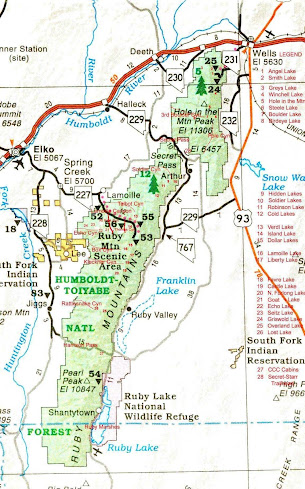When a lot of people think of Nevada they either think of Las Vegas or a dry hot desert. While these are both truths, they are not the whole story! Nevada has some incredible diversity, and one place it can be found is in the Ruby Mountains, located just outside the town of Elko, Nevada.
Elko is geographically isolated, 4 hours west of Salt Lake City, Utah, 5 hours east of Reno, Nevada, 7 hours north of Las Vegas and 4 hours south of Boise, Idaho. Elko isn’t necessarily a small town, there is a population of about 20,000 within the city limits and 50,000 in Elko County, and there are a lot of amenities here in town, however, if it isn’t in Elko, it’s a commitment! With all that being said, one thing we do like to boast about is that the Ruby Mountains are in our backyard.
Find this map and a lot more information at Hiking the Ruby Mountains at http://rubymountains.net/.
Known as Nevada's Swiss Alps, the Ruby Mountains are found in the Humboldt National Forest. The Ruby Mountains run approximately 90 miles in length and are about 10 miles wide. The range runs in a generally north-south direction. The mountain range has a gentler slope on the west side, the side viewed from Elko, and a more steep slope on the east side, or the Ruby Valley side. The highest elevations are in the 10,000 to 11,000 foot range. The Ruby Mountains houses 25 - 28 named lakes, depending who’s counting, as well as a number of small unnamed lakes or large ponds. Altogether, there is an estimated 100-miles of hiking trails in the Ruby Mountains.
The popular Lamoille Canyon can be the beginning or the end of the Ruby Crest Trail, depending if you decide to travel north or south. The Ruby Crest Trail runs from Lamoille Canyon to Harrison Pass, covering about 40 miles. Depending on what you read, the description varies from 35 - 43 miles. There are several different entry points, which is probably why there is such variability in the explanation of the length of the trail. We hiked Harrison Pass to Roads End at Lamoille Canyon and got to see a level of unexpected diversity in vegetation. From aspen groves to barren of green plants, but lichen covered stretches of rock and gravel, it was hard to believe we were in the same mountain range the whole time.
Pippi (author) overlooking Overland Lake during the storm.
The Leave No Trace Principle that we really adhered to on this trip was Plan Ahead and Prepare. Because no one in our party had done this hike before, we were very nervous about staying on the trail. We ended up bringing two different maps because each had different details, and there were several times when at a cross-trail that we had both maps available to discern which trail to take. This also helped us with water planning. We hiked the Ruby Crest towards the end of July and it was important to be aware of potential water sources and have a plan. Thankfully, there was more water than we expected with many springs still running strong. We also checked the weather and were anticipating afternoon thunderstorms, and Mother Nature did not disappoint. We heard some spectacular thunder and was pelted for just a bit with a hail-rain mix. One of the great things about Nevada is that the rain rarely lasts very long, and because of the low humidity, within not too long you are dry again. It was fun to have the opportunity to pull out our backpack covers and ponchos, because, seriously, we are in a desert after all and it just really does not rain that often. Had we not been prepared however, it may not have been such a fun diversion from our typical blue skies.
Another Leave No Trace Principle that deserves highlighting is Dispose of Waste Properly. No one likes to think, much less talk about, going to the bathroom in the backcountry. But, it’s a reality that one must face at some point. Our group likes to carry homemade “potty bags”. Gallon zip lock bags covered in duct tape to help hide the contents, and ensure their integrity. One of our members went all out this year making her potty bag! She included a strap and pockets for wipes and hand sanitizer!
Becky’s (authors friends) super snazzy potty bag.
No one wants to see your toilet paper, so be sure to pack out your waste, and not just potty waste. Be aware of your trash and be sure you take it all with you when you leave an area. Having a dedicated trash bag for potty waste, and then a bag for general waste helps keep your pack organized and clean.
This was a great adventure, but you do need to be in pretty good shape because there is quite a bit of climbing as you do traverse through and over several canyons and ridges. We did not see any wildlife, beyond two rattlesnakes near Harrison Pass, but the wildflowers were on full display and were magnificent. It would be fun to do this trail again, since it is in our backyard, going the opposite direction and at a different time of year just to see what it looks like. It was a great get-away in a year where travel is limited. How fortunate we are to have world-class backpacking just 45 minutes away.
Get outside and hike on, there is so much to see!
“Pippi”
A.K.A., Brandolyn Thran, Elko Admin and Outreach Coordinator




No comments:
Post a Comment